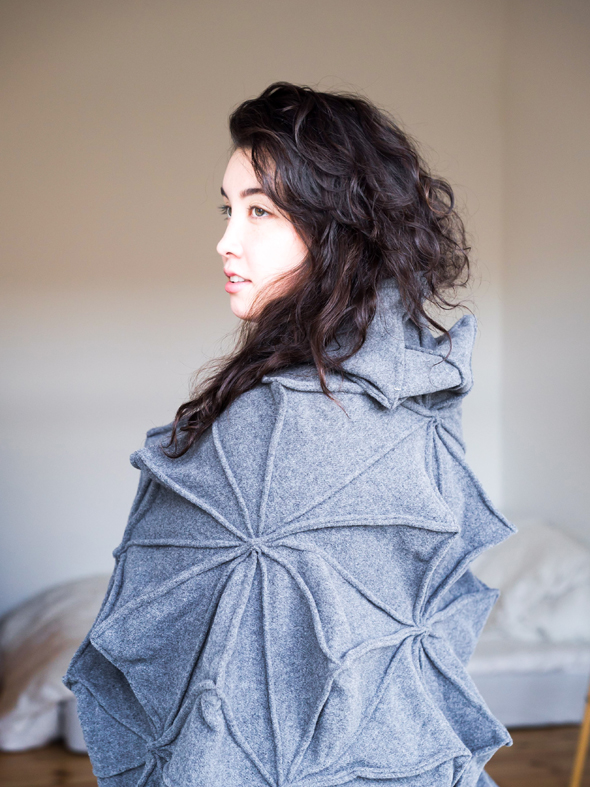The Creation of Bloom Blanket and Return to Self

The Skype call came in from Berlin, Germany in the early morning hours. It had been almost a decade since I had seen Bianca. She appeared on the screen, freckles now dotting her porcelain skin, which contrasted against a shock of wavy, dark hair. Her eyes were the same. Grey-green eyes full of laughter and light, just like I remembered. We grew up together as close friends in junior high, but now at just twenty-five years old, Bianca Cheng Costanzo is the sole creator and owner of her company, Bloom Blanket.
The product, an Italian wool cashmere blanket, is an undeniable feat in design and the perfect meld of geometry and art. The blanket is inspired by Ron Resch’s origami tessellations in the 1960’s, where the paper could be stretched and then folded back into repeating, geometrical patterns. Bianca experimented with Resch’s tessellations, translating them from paper into textiles. Nearly forty prototypes later, the Bloom Blanket was born.
Bianca made a Kickstarter online to fund her Bloom Blanket’s manufacturing costs. They were fairly expensive, since she was set on making the blankets out of high-end cashmere. So she set her asking price at $14,050. However, to her surprise, the idea caught on like wildfire and went viral. She raised over fourteen times that amount, totaling $204,335.
Bianca was always an exceptionally gifted kid. I remember gawking at her flawless report cards, A pluses beside every subject. She’s a gorgeous combination of Chinese and Italian descent and was originally born in Sao Paulo, Brazil. As a child, she was fluent in Italian, Portuguese, English, and French. She has since added Spanish and Swedish to that list and is currently learning German—do try to keep up. Unsurprisingly, she was accepted into MIT, and studied there a year before moving on to design for Apple. Bianca had everything going for her, until tragedy cut it all short.
During a bike ride, Bianca rode down a steep, winding hill. She wasn’t sure of what exactly happened next, but her bike crashed and her head went into a wall. Without her helmet, she wouldn’t have survived. However, the crash was severe enough to put her into a coma for thirty-five days. The accident resulted in several broken vertebrae, a broken wrist and emergency brain surgery. When she woke up, her head was shaved and her memory was damaged. Bianca couldn’t remember who or where she was and had to go through the long, arduous process of reacquiring her memories. The girl with perfect grades, who was accepted into MIT, had to relearn two-plus-two.
After her recovery, Bianca left Apple and took a year to travel the world, meditate and reconnect with her sense of self. I asked her if Bloom was part of her healing process and the answer was yes. “Bloom was an extremely personal project. It speaks to a lot of ideas that come from my upbringing, my past, my family and my development as a creative individual. So yeah, it was a healing process of re-finding myself.”
As a child, Bianca used to do origami with her mother. Her grandfather owned a furniture factory in Brazil that dealt with various textiles. So combining textile and origami landed within the spectrum of what she describes as her “natural language.” She explained her design process as iterating: to repeat and make different versions of products. This process was a way of life on the Apple design team, and ended up contributing to the creation of Bloom.
“At Apple, they not only teach you to really iterate, to repeat and sequentially progress on a project and go several different directions at the same time, but also to present the sequential exploration. Like ‘Hey, here’s my thought process and here’s why this thing makes sense.’ Then I realized from working on my own [on Bloom], that I still do that because I was actually just trying to explain it [the artistic thought process] to myself.”
Bloom isn’t Bianca’s only creative venture. She’s also working on a fashion/technology project in collaboration with Elektro Couture called “Marea,” inspired by her connection with the sea since childhood. Additionally, she has a band in Spain called “De Volta,” which in Portuguese translates to the apropos title, “The Return.” Return and repetition are themes not only in Bianca’s creative exploration, but in her life as well.
After her bike accident, Bianca had to repeat and relearn all the fundamentals from her past. The inspiration for Bloom Blanket, which ended up establishing her as an independent creative, drew upon her returning to her childhood memories. The repeating sequential, origami patterns in her Bloom Blanket seem to be a map of her own life, where she returns back to her sense of self, and repeats it back in the form of art.
Text by Zee Chang
Photograph by Rosemary Liss

